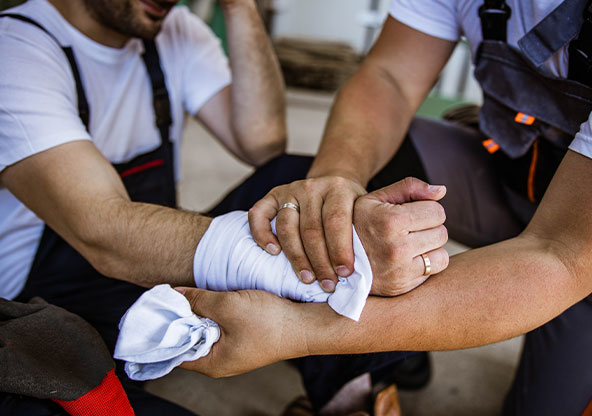Call 911 in an emergency
In any emergency situation, you should always call 911 before taking further action.
How to Stop the Bleed

In emergencies, the ability to stop severe bleeding cases significantly impacts saving lives. Whether it’s from an accident, assault, or natural disaster, time is of the essence.
Knowing how to act can mean the difference between life and death.
The following are some quick tips to help you STOP THE BLEED immediately.
Call 911
The sight of blood for some people can be terrifying, especially when it’s a severe injury.
Still, the best thing to do is to not panic. Panicking will not help stop the bleeding—the very thing you should focus on. In some cases, it can even make the situation worse.
The very first steps you should take are to:
- Make sure the scene is safe.
- If it’s not safe, get yourself and the victim to safety if possible.
- Once in a safe area, use your cell phone to dial 9-1-1. If you do not have one on you, ask someone nearby.
- Provide the operator with your location, describe the situation, and follow all their instructions.
Apply Pressure with Hands
Once you’ve called 911, and the paramedics are on the way, you need to tend to the patient. Every second is critical, so you need to find a way to put pressure on the wound to stop bleeding as quickly as possible.
First, if you have access to a trauma kit, put gloves on, then use the pair of shears to cut through any clothing to expose all injuries with uncontrolled bleeding. If there isn’t a trauma kit available, make do with what you have. The most important goal is to stop the bleeding.
Next, use both hands to apply direct pressure to the wounded area. If you don’t have gloves, use a clean article of clothing to apply pressure. In most cases, the bleeding will stop, but bear in mind that there are some instances where pressure won’t help.
You may have to kneel and straighten your elbows to get maximum compression. Do not release until paramedics arrive and tell you to do so.
Pack Wound and Press
Applying pressure doesn’t seem to be doing the trick?
If applying pressure for 3-5 minutes isn’t working, the next step would be to pack the wound.
Pack the wound using a clean gauze or cloth from your trauma kit if it’s on the neck, shoulder, or groin.
Once packed, use your hands and fingers to press as much of it into the wound as possible before applying pressure again to the bleeding site. Do this until the bleeding stops or medical emergency personnel relieves you from duty.
Apply Tourniquet
You’ve done everything from calling 911 to applying pressure to the wound area to packing it to applying pressure again, and the bleeding still hasn’t stopped.
Your last resort from your trauma kit will be a tourniquet. Designed for arm and leg use only, they should not be used on the head, neck, torso, or groin.
First, open the tourniquet into a loop position. Then, wrap it around the body, two inches above the wound area—DO NOT place it over the elbow or knee.
Finally, tighten the tourniquet and hold it tightly until the bleeding stops.
A second one may be required if it does not stop.
If you can write down the time of application, do so on the tourniquet so paramedics are aware.
About STOP THE BLEED®
STOP THE BLEED® is a groundbreaking campaign that helps bystanders respond to an emergency with excessive bleeding. By learning what steps to take in such situations, bystanders are better equipped to assist.
STOP THE BLEED®, a national awareness campaign led by the American College of Surgeons Committee on Trauma (ACS COT), offers courses that train the public to assist in bleeding emergencies before help arrives.
For more information on STOP THE BLEED® and how it’s saving lives, visit stopthebleed.org.
